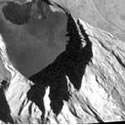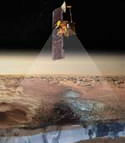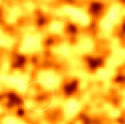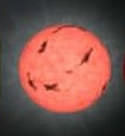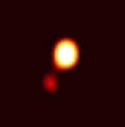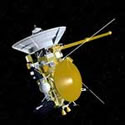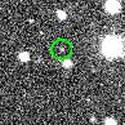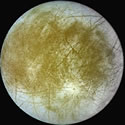
Image credit: NASA
The evidence is mounting that Europa, one of the moons of Jupiter, has an ocean of water covered by a sheet of ice. Scientists are now speculating about how thick that ice is by measuring the size and depth of 65 impact craters on the moon’s surface – from what they can tell, it’s 19 km. The thickness of Europa’s ice will have an impact on the possibility of finding life there: too thick and sunlight will have trouble reaching photosynthetic organisms.
Detailed mapping and measurements of impact craters on Jupiter?s large icy satellites, reported in the May 23, 2002, issue of the journal Nature, reveal that Europa?s floating ice shell may be at least 19 kilometers thick. These measurements, by Staff Scientist and geologist Dr. Paul Schenk, at Houston?s Lunar and Planetary Institute, indicate that scientists and engineers will have to develop new and clever means of searching for life on the frozen world with a warm interior.
The Great Europa Pizza Debate: “Thin Crust or Thick Crust?”
Geologic and geophysical evidence from Galileo support the idea that a liquid water ocean exists beneath the icy surface of Europa. The debate now centers on how thick this icy shell is. An ocean could melt through a thin ice shell only a few kilometers thick exposing water and anything swimming in it to sunlight (and radiation). A thin ice shell could melt through, exposing the ocean to the surface, and granting easy access of photosynthetic organisms to sunlight. A thick ice shell tens of kilometers thick would be very unlikely to melt through.
Why is the thickness of Europa’s icy shell important?
The thickness is an indirect measure of how much tidal heating Europa is getting. Tidal heating is important for estimating how much liquid water is on Europa and whether there is volcanism on Europa?s sea floor but it must be derived; it cannot be measured. The new estimate of a 19 kilometer thickness is consistent with some models for tidal heating, but requires much additional study.
The thickness is important because it controls how and where biologically important material in Europa’s ocean can move to the surface, or back down to the ocean. Sunlight cannot penetrate more than a few meters into the icy shell, so photosynthetic organisms require easy access to Europa’s surface to survive. More on this subject later.
The thickness will also ultimately determine how we can explore Europa’s ocean and search for evidence of any life or organic chemistry on Europa. We cannot drill or sample the ocean directly through such a thick crust and must develop clever ways to search for ocean material that may have been exposed on the surface.
How do we estimate the thickness of Europa?s ice shell?
This study of impact craters on the large icy Galilean satellites of Europa is based on a comparison of the topography and morphology of impact crater on Europa with those on its sister icy satellites Ganymede and Callisto. Over 240 craters, 65 of them on Europa, have been measured by Dr. Schenk using stereo and topographic analysis of images acquired from NASA?s Voyager and Galileo spacecraft. Galileo is currently orbiting Jupiter and heading toward its final plunge into Jupiter in late 2003. Although both Ganymede and Callisto are believed to have liquid water oceans inside, they are also inferred to be rather deep (roughly 100-200 kilometers). This means that most craters will be unaffected by the oceans and can be used for comparison with Europa, where the depth to the ocean is uncertain but likely to be much shallower.
The estimate of the thickness of Europa?s ice shell is based on two key observations. The first is that the shapes of Europa?s larger craters differ significantly from similar sized craters on Ganymede and Callisto. Dr. Schenk?s measurements show that craters larger 8 kilometers across are fundamentally differ from those on Ganymede or Callisto. This is due to the warmth of the lower part of the ice shell. The strength of ice is very sensitive to temperature and warm ice is soft and flows rather quickly (think glaciers).
The second observation is that morphology and shape of craters on Europa change dramatically as crater diameters exceed ~30 kilometers. Craters smaller than 30 kilometers are several hundred meters deep and have recognizable rims and central uplifts (these are standard features of impact craters). Pwyll, a crater 27 kilometers across, is one of the largest of these craters.
Craters on Europa larger than 30 kilometers, on the other hand, have no rims or uplifts and have negligible topographic expression. Rather they are surrounded by sets of concentric troughs and ridges. These changes in morphology and topography indicate a fundamental change in the properties of the icy crust of Europa. The most logical change is from solid to liquid. The concentric rings in large Europan craters are probably due to the wholesale collapse of the crater floor. As the originally deep crater hole collapses, the material underlying the icy crust rushes in to fill in the void. This inrushing material drags on the overlying crust, fracturing it and forming the observed concentric rings.
Where does the 19 to 25 kilometer value come from?
Larger impact craters penetrate more deeply into the crust of a planet and are sensitive to the properties at those depths. Europa is no exception. The key is the radical change in morphology and shape at ~30 kilometers crater diameter. To use this, we must estimate how big the original crater was and how shallow a liquid layer must be before it can affect the final shape of the impact crater. This is derived from numerical calculations and laboratory experiments into impact mechanics. This ?crater collapse model? is then used to convert the observed transition diameter to a thickness for the layer. Hence, craters 30 kilometers wide are sensing or detecting layers 19-25 kilometers deep.
How certain are these estimates of Europa?s ice shell thickness?
There is some uncertainty in the exact thickness using these techniques. This is due mostly to uncertainties in the details of impact cratering mechanics, which are very difficult to duplicate in the laboratory. The uncertainties are probably only between 10 and 20%, however, so we can be reasonably sure that Europa’s ice shell is not a few kilometers thick.
Could the ice shell have been thinner in the past?
There is evidence in the crater topography that the thickness of ice on Ganymede has changed over time, and the same might be true for Europa. The estimate for ice shell thickness of 19 to 25 kilometers is relevant to the icy surface we now see on Europa. This surface has been estimated to be 30 to 50 million years or so. Most surface materials older than this have been destroyed by tectonism and resurfacing. This older icy crust could have been thinner than today?s crust, but we presently have no way of knowing.
Could the ice shell on Europa have thin spots now?
The impact craters Dr. Schenk studied were scattered across Europa?s surface. This suggests that the ice shell is thick everywhere. There could be local areas where the shell is thin due to higher heat flow. But the ice at the base of the shell is very warm and as we see in glaciers here on Earth, warm ice flows fairly rapidly. As a result, any ?holes? in Europa?s ice shell will be filled in quickly by flowing ice.
Does a thick ice shell mean there is no life on Europa?
No! Given how little we know about the origins of life and conditions inside Europa, life is still plausible. The probable presence of water under the ice is one of the key ingredients. A thick ice shell makes photosynthesis highly unlikely on Europa. Organisms would not have rapid or easy access to the surface. If organisms inside Europa can survive without sunlight, then the thickness of the shell is of only secondary importance. After all, organisms do quite well on the bottom of Earth?s oceans quite well without sunlight, surviving on chemical energy. This could be true on Europa if it is possible for living organisms to originate in this environment in the first place.
Then too, Europa’s ice shell could have been much thinner in the distant past, or perhaps it didn’t exist at some point and the ocean was exposed naked to space. If that were true, then a variety of organisms could evolve, depending on chemistry and time. If the ocean began to freeze over, the surviving organisms could then evolve to whatever environments allowed them to survive, such as volcanoes on the ocean floor (if volcanoes form at all).
Can we explore for life on Europa if the ice shell is thick?
If the crust is indeed this thick, then drilling or melting through the ice with tethered robots would be impractical! Nonetheless, we can search for organic ocean chemistry or life in other locations. The challenge will be for us to devise a clever strategy for exploring Europa that won?t contaminate what is there yet find it nonetheless. The prospect of a thick ice shell limits the number of likely sites where we might find exposed oceanic material. Most likely, ocean material will have to be embedded as small bubbles or pockets or as layers within ice that has been brought to the surface by other geologic means. Three geologic processes could do this:
1. Impact craters excavate crustal material from depth and eject it out onto the surface, where we might pick it up (50 years ago we could pick up iron meteorite fragments on the flanks of Meteor Crater in Arizona, but most have been found by now). Unfortunately, the largest known crater on Europa, Tyre, excavated material from only 3 kilometers deep, not deep enough to get near the ocean (due to geometry and mechanics, craters excavate from the upper part of the crater, not the lower). If a pocket or layer of ocean material were frozen into the crust at shallow depth, it might be sampled by an impact crater. Indeed, the floor of Tyre has a color that is slightly more orange than the original crust. However, roughly half of Europa was well seen by Galileo, so a larger crater might be present on the poorly seen side. We will have to go back to find out.
2. There is strong evidence that Europa?s icy shell is somewhat unstable and has been (or is) convecting. This means that blobs of deep crustal material rise upward toward the surface where they are sometimes exposed as domes several kilometers wide (think Lava Lamp, except that the blobs are soft solid material like Silly Putty). Any ocean material imbedded within the lower crust could then be exposed to the surface. This process could take thousands of years, and the exposure to Jupiter?s lethal radiation would be unfriendly to say the least! But at least we could investigate and sample what remains behind.
3. Resurfacing of wide areas of Europa?s surface where the icy shell has literally torn through and split apart. These areas are not empty but have been filled with new material from below. These areas do not appear to have been flooded by ocean material, but rather by soft warm ice from the bottom of the crust. Despite this it is very possible that oceanic material could be found within this new crustal material.
Our understanding of Europa’s surface and history is still very limited. Unknown processes could occur that bring ocean material to the surface, but only a return to Europa will tell.
What next for Europa?
With the recent cancellation of a proposed Europa Orbiter due to cost overruns, this is a good time to reexamine our strategy for exploring Europa?s ocean. Tethered submarines and deep drilling probes are rather impractical in such a deep crust, but surface landers could be very important nonetheless. Before we send a lander to the surface, we should send a reconnaissance mission, in either Jupiter or Europa orbit, to search for exposures of ocean material and thin spots in the crust, and to scout out the best landing sites. Such a mission would make use of vastly improved infrared mapping capabilities for mineral identification (after all, the Galileo instruments are nearly 25 years old). Stereo and laser instruments would be used for topographic mapping. Together with gravity studies, these data could be used to search for relatively thin regions of the icy crust. Finally, Galileo observed less than half of Europa at resolutions sufficient for mapping, including impact craters. Craters on this poorly seen hemisphere, for example, could indicate whether Europa?s ice shell was thinner in the past.
A Lander for Europa?
A lander with a seismometer could listen for europa-quakes generated by the daily tidal forces exerted by Jupiter and Io. Seismic waves can be used to precisely map the depth to the bottom of the ice shell, and possibly the bottom of the ocean as well. Onboard chemical analyzers would then search for organic molecules or other biologic tracers and potentially determine ocean chemistry, one of the fundamental indicators of Europa?s prospects as an ?inhabited? planet. Such a lander would probably need to drill several meters to get through the zone of radiation damage at the surface. Only after these missions are under way can we then begin the true exploration of this tantalizing planet-sized moon. To paraphrase Monty Python, ?It?s not dead yet!?
Original Source: USRA News Release
